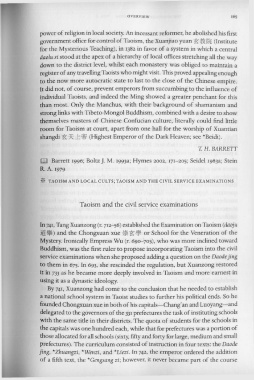Page 205 - The Encyclopedia of Taoism v1_A-L
P. 205
O VE RVIE W 165
power of religion in local society. An incessant reformer, he abolished his first
government office for control of Taoism, the Xuanjiao yuan ~ #J. [lJG (Institute
for the Mysterious Teaching), in 1382 in favor of a system in which a central
daolu si stood at the apex of a hierarchy of local offices stretching all the way
down to the district level, whilst each monastery was obliged to maintain a
register of any travelling Taoists who might visit. This proved appealing enough
to the now more autocratic state to last to the close of the Chinese empire.
it did not, of course, prevent emperors from succumbing to the influence of
individual Taoists, and indeed the Ming showed a greater penchant for this
than most. Only the Manchus, with their background of shamanism and
strong links with Tibeto-Mongol Buddhism, combined with a desire to show
them elves masters of Chinese Confucian culture, literally could find little
room for Taoism at court, apart from one hall for the worship of Xuantian
shangdi ~ 7C J: * (Highest Emperor of the Dark Heaven; see *Beidi).
T. H. BARRETT
W Barrett 1996; Boltz J. M. 1993a; Hymes 2002, 171-205; Seidel 1983a; Stein
R. A. 1979
* TAOISM AND LOCAL CULTS; TAOISM AND THE CIVIL SERVICE EXAMINATIONS
Taoism and the civil service examinations
In 741, Tang Xuanzong (r. 712-56) established the Examination on Taoism (daoju
J!t ~) and the Chongxuan xue *' ~ ~ or School for the Veneration of the
Mystery Ironically Empress Wu (r. 690-705), who was more inclined toward
Buddhism, was the first ruler to propose incorporating Taoism into the civil
service examinations when she proposed adding a question on the Daode jing
to them in 675. In 693, she rescinded the regulation, but Xuanzong restored
it in 733 as he became more d~eply involved in Taoism and more earnest in
using it as a dynastic ideology
By 741, Xuanzong had come to the conclusion that he needed to establish
a national school system in Taoist studies to further his political ends. So he
founded Chongxuan xue in both of his capitals-Chang'an and Luoyang- and
delegated to the governors of the 331 prefectures the task of instituting schools
with the same title in their districts. The quota of students for the schools in
the capitals was one hundred each, while that for prefectures was a portion of
those allocated for all schools (sixty, fifty and forty for large, medium and small
prefectures). The curriculum consisted of instruction in four texts: the Daode
jing, *Zhuangzi, *Wenzi, and *Liezi. In 742, the emperor ordered the addition
of a fifth text, the *Gengsang zi; however, it never became part of the course

